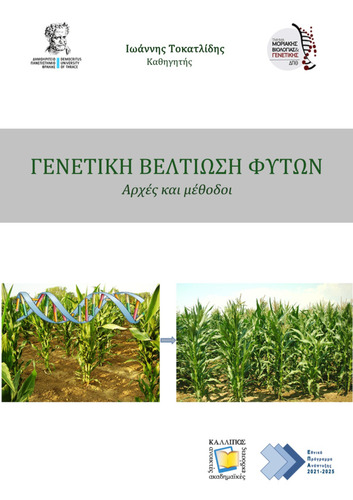| Title Details: | |
|
Plant breeding |
|
| Other Titles: |
Principles and methods |
| Authors: |
Tokatlidis, Ioannis |
| Reviewer: |
Vlachostergios, Dimitrios Mavromatis, Athanasios Papasotiropoulos, Vasilios Katsiotis, Andreas Aravanopoulos, Filippos Ralli, Parthenopi |
| Subject: | NATURAL SCIENCES AND AGRICULTURAL SCIENCES > AGRICULTURAL SCIENCES > PLANT SCIENCE AND PLANT PRODUCTS > AGRONOMY NATURAL SCIENCES AND AGRICULTURAL SCIENCES > AGRICULTURAL SCIENCES > PLANT SCIENCE AND PLANT PRODUCTS > PLANT BREEDING NATURAL SCIENCES AND AGRICULTURAL SCIENCES > AGRICULTURAL SCIENCES > PLANT SCIENCE AND PLANT PRODUCTS > PLANT BREEDING > PLANT VARIETY PROTECTION NATURAL SCIENCES AND AGRICULTURAL SCIENCES > AGRICULTURAL SCIENCES > PLANT SCIENCE AND PLANT PRODUCTS > PLANT CHARACTERISTICS > AGRONOMIC TRAITS NATURAL SCIENCES AND AGRICULTURAL SCIENCES > AGRICULTURAL SCIENCES > PLANT SCIENCE AND PLANT PRODUCTS > PLANT CHARACTERISTICS > SEED PRODUCTIVITY NATURAL SCIENCES AND AGRICULTURAL SCIENCES > AGRICULTURAL SCIENCES > PLANT SCIENCE AND PLANT PRODUCTS > PLANT ECOLOGY |
| Keywords: |
Agroecosystem
Additive gene action Hybrid reconstruction Competition Conservation breeding Optimum density Open pollinated line Nil-competition Breeder equation Acquired inequality Inbred vigor Productive ideotype Landrace Breeding experimental designs Cultivar plasticity Density independent cultivar Stability Non-stop selection Yield gap Spatial heterogeneity |
| Description: | |
| Abstract: |
This manual presents a new approach to plant breeding based on the inviolable rule of plant selection in the absence of competition. The new methodology is analyzed comparatively with the typical one applied under competition between genotypes. The text includes four sections with individual chapters (general part, breeding principles, breeding methods, and special breeding issues). The general part focuses on the mode of plant reproduction and its implications for genetic evolution, the type of varieties and stages of cultivar development and commercialization, and the nature and expression of complex quantitative traits. Breeding principles include the creation and protection of genetic variability, factors that affect the genotype selection efficiency (particular emphasis is placed on the role of competition between individual plants in either the crop or breeding experiment), and experimental models used in plant breeding with a focus on the honeycomb breeding designs invented for selection in the absence of competition. Breeding methods include mass selection, pedigree selection, hybridization, backcrossing, polyploidy and generation of doubled haploid lines, applied in both regimes of allo-competition and nil-competition; in addition, the molecular approach to plant breeding is described. Finally, two special chapters refer to the need for continuous (non-stop) selection procedures, the first as a means of landrace diversity stewardship to upgrade and exploit their genetic variability, and the second concerning a conservation breeding to prolong longevity and commercial acceptance of elite cultivars.
|
| Linguistic Editors: |
Pitsoli, Kalli |
| Graphic Editors: |
Dedikousi, Stamatia |
| Type: |
Undergraduate textbook |
| Creation Date: | 13-06-2023 |
| Item Details: | |
| ISBN |
978-618-228-024-9 |
| License: |
Attribution - NonCommercial - ShareAlike 4.0 International (CC BY-NC-SA 4.0) |
| DOI | http://dx.doi.org/10.57713/kallipos-254 |
| Handle | http://hdl.handle.net/11419/9755 |
| Bibliographic Reference: | Tokatlidis, I. (2023). Plant breeding [Undergraduate textbook]. Kallipos, Open Academic Editions. https://dx.doi.org/10.57713/kallipos-254 |
| Language: |
Greek |
| Consists of: |
1. Introduction 2. Plant reproduction 3. Plant breeding subject 4. Quantitative traits 5. Genetic variability 6. Factors affecting selection 7. Crop and competition 8. Plant breeding and competition 9. Experimental designs in plant breeding 10. Mass selection scheme 11. Pedigree selection scheme 12. Hybrid development methods 13. Backcrossing 14. Ploidy and plant breeding 15. Molecular approach to plant breeding 16. Landrace stewardship 17. Conservation breeding of elite cultivars |
| Number of pages |
360 |
| Publication Origin: |
Kallipos, Open Academic Editions |
| You can also view | |
| User comments | |
There are no published comments available! | |

